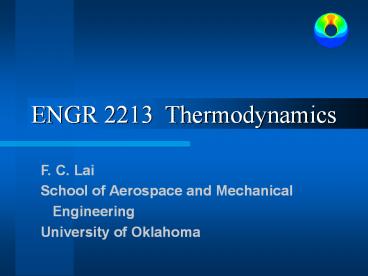ENGR 2213 Thermodynamics - PowerPoint PPT Presentation
Title:
ENGR 2213 Thermodynamics
Description:
Engineering. University of Oklahoma. Second Law of Thermodynamics ... isothermal expansion process Q12 = 40 kJ, Find. the highest and the lowest temperatures in the ... – PowerPoint PPT presentation
Number of Views:120
Avg rating:3.0/5.0
Title: ENGR 2213 Thermodynamics
1
ENGR 2213 Thermodynamics
- F. C. Lai
- School of Aerospace and Mechanical
- Engineering
- University of Oklahoma
2
Second Law of Thermodynamics
Perpetual-Motion Machines
Any device that violates either the first or the
second law of thermodynamics is called a
perpetual-motion machine.
Perpetual-Motion Machines of the First Kind
Devices that violates the first law of
thermodynamics.
Perpetual-Motion Machines of the Second Kind
Devices that violates the second law of
thermodynamics.
3
Second Law of Thermodynamics
Perpetual-Motion Machines of the First Kind
W
QL
4
Second Law of Thermodynamics
Perpetual-Motion Machines of the Second Kind
QOUT
5
Second Law of Thermodynamics
Perpetual-Motion Machines of the Second Kind
QIN
W
6
Second Law of Thermodynamics
Cold Fusion
7
Second Law of Thermodynamics
Cold Fusion
http//www.ncas.org/erab/index.html
8
Second Law of Thermodynamics
Reversible Process
A process which can be reversed without leaving
any trace on the surroundings.
Both the system and the surroundings are
returned to their initial states at the end of
the reversed process.
Reversible processes actually do not occur in
nature. They are merely idealizations of actual
processes.
9
Second Law of Thermodynamics
Irreversibilities
The factors that cause a process to be
irreversible.
? Friction
? Unrestrained Expansion
? Mixing of Two Gases
? Heat Transfer across a Finite Temperature
Difference
? Electrical Resistance
? Chemical Reactions
10
Second Law of Thermodynamics
Reversible Cycles
Cycles that consist entirely of reversible
processes.
Carnot Cycle
? the best known reversible cycle.
? proposed in 1824 by French engineer Sadi
Carnot.
? composed of four reversible processes, two
isothermal and two adiabatic.
11
Second Law of Thermodynamics
Carnot Power Cycle
1. Reversible isothermal expansion (1-2).
2. Reversible adiabatic expansion (2-3).
3. Reversible isothermal compression (3-4).
4. Reversible adiabatic compression (4-1).
1
QH
p
2
Wnet
QL
4
3
v
12
Second Law of Thermodynamics
Carnot Refrigeration Cycle
1. Reversible adiabatic expansion (1-2).
2. Reversible isothermal expansion (2-3).
3. Reversible adiabatic compression (3-4).
4. Reversible isothermal compression (4-1).
1
QH
p
4
Wnet
QL
2
3
v
13
Second Law of Thermodynamics
Carnot Principles
- The efficiency of an irreversible heat engine is
- always less than that of a reversible one
- operating between the same two reservoirs.
- The efficiencies of all reversible heat engines
- operating between the same two reservoirs
- are the same.
A violation of either statement results in the
Violation of the second law of thermodynamics.
14
Proof of the First Carnot Principle
High-temperature Reservoir at TH
QH
QH
Assume ?Irr gt ?Rev
WIrr gt WRev
Rev HE
Irrev HE
QL, Irr lt QL, Rev
WIrr
WRev
QL, Rev
QL, Irr
Low-temperature Reservoir at TL
15
Proof of the First Carnot Principle
High-temperature Reservoir at TH
QH
QH
WIrr - WRev
Rev Ref
Irrev HE
Irrev Rev HE Ref
WIrr
QL, Irr
QL, Rev
QL,Rev QL, Irr
Low-temperature Reservoir at TL
16
Second Law of Thermodynamics
Carnot Principles
- The efficiencies of all reversible heat engines
- operating between the same two reservoirs
- are the same.
The efficiency of a reversible engine is
independent of the working fluid employed
and its properties, the way the cycle is
executed, or the type of reversible engine used.
17
Second Law of Thermodynamics
? f(QH, QL)
Since the energy reservoirs are characterized
by their temperatures,
? f(TH, TL)
A
B
C
18
Second Law of Thermodynamics
f(T1, T3) f(T1, T2) f(T2, T3)
What kind of function f would be?
19
Second Law of Thermodynamics
What kind of function F would be?
Several functions are possible, and the choice is
completely arbitrary.
? Lord Kevin first propose that F(T) T.
This equation partially defines the
absolute temperature.
20
Second Law of Thermodynamics
Efficiency of a Heat Engine
Carnot Heat Engines
The efficiency of Carnot heat engine is the
highest efficiency a heat engine operating
between the two reservoirs at temperature TH and
TL can have.
21
Second Law of Thermodynamics
Efficiency of a Heat Engine
lt ?th, rev
Irreversible heat engines
?th
?th, rev
Reversible heat engines
gt ?th, rev
Impossible heat engines
Maximize the Efficiency of a Real Engine
? Supply heat at the highest possible temperature
? Reject heat at the lowest possible temperature
22
Example 1
- 0.5 kg of air undergoes a Carnot cycle with ?
0.5. - Given the initial pressure p1 700 kPa, initial
- volume V1 0.12 m3 and heat transfer during the
- isothermal expansion process Q12 40 kJ, Find
- the highest and the lowest temperatures in the
- cycle.
- (b) the amount of heat rejection.
- (c) work in each process.
23
Example 1 (continued)
Carnot cycle
TL 292.7 K
24
Example 1 (continued)
Carnot cycle
QL 20 kJ
Process 1-2 T1 T2
?U12 Q12 W12
W12 Q12 40 kJ
Process 2-3 Q23 0
?U23 Q23 W23
25
Example 1 (continued)
W23 m(u2 u3)
0.5(423.7 208.8) 107.5 kJ
Process 3-4 T3 T4
?U34 Q34 W34
W34 Q34 -20 kJ
Process 4-1 Q41 0
?U41 Q41 W41
W41 m(u4 u1)
0.5(208.8 423.7) -107.5 kJ































